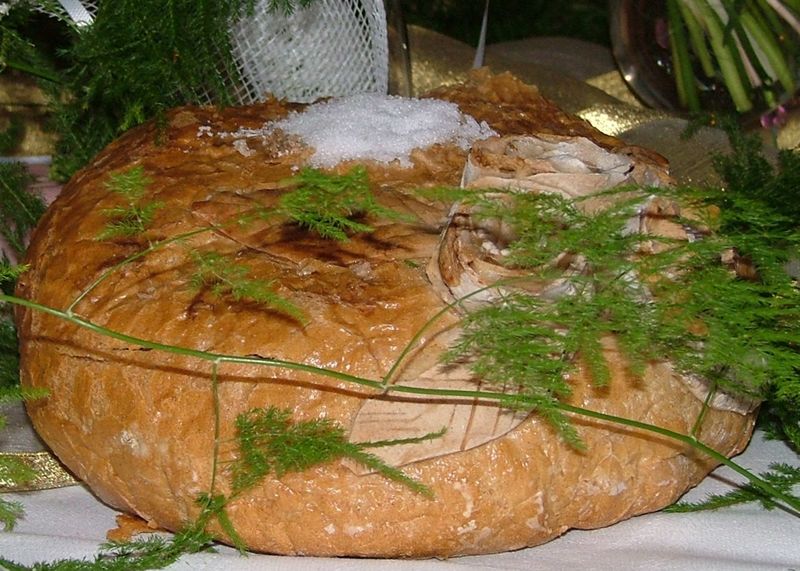Polish Wedding
Polish weddings, rich in traditions, often include both a religious ceremony and a festive reception where the bride and groom receive bread, salt, and wine from their parents as symbols of prosperity, resilience, and abundance. Key customs include singing the celebratory song "Sto lat," the bride and groom's first dance, and numerous vodka toasts, with guests chanting "gorzko, gorzko" to prompt the couple to kiss. At midnight, the bride tosses her veil to single women and the groom his tie to single men, symbolizing who might marry next, and the festivities can extend into a second day known as "popraviny."
Polish Wedding
Most people in Poland are Roman Catholics so the religious wedding ceremony is more or less the same as those of other Catholics in other countries. But, the same as in every country Poland has numerous traditions related to, for many, the most important event in the life.
Being invited to the wedding (wesele, ślub) often means you have been invited to the wedding ceremony and not the wedding reception. So, get informed if you are not sure.
Many Polish couples get married in the month that in its name has letter R as it is considered good luck to do it.
In Poland a bride and groom arrive to a church and walk towards the main altar together.
It is considered bad luck if the bride wears shoes with her fingers visible and jewellery with pearls.
There are some old beliefs related with the relations within marriage. If the bride tries to cover part of groom's shoes she is wishing for her dominance in the relationship.
When out of the church the newlyweds have to pick up all the coins that have been thrown upon them by the people attending the wedding. After that everyone congratulates the bride and groom. The groom is getting envelopes with some money. He gives them to the best man. The bride gets flowers. She gives them to her bridesmaid.
Talking of bridesmaids, there is an old belief saying that the bridesmaid who after the wedding ceremony first touches the bride is going to get married during next year.

Wedding reception is held in a restaurant, hotel or at home. Upon arrival bride and groom get bread, salt and sometimes little bit of wine. This act has a symbolic meaning. Bread is often decorated with names of the bride and groom. Bread is served as a wish of future life without hunger. Wine symbolizes wish that the new family will never go thirsty. Salt on the other side symbolizes problems in life and need to handle them properly. In ancient beliefs salt also had the power to ward off evil spirits.
During the mentioned tradition either of their parents say the following lines.
"Staropolskim zwyczajem witamy Was chlebem i sola, aby w Waszym domu zawsze goscil dostatek."
or in English
"According to our Old Polish tradition, we greet you with bread and salt, so that your home might always enjoy abundance."
When arriving at the wedding reception other guests get some drink.
The wedding reception starts with the most famous of all Polish party songs "Sto lat" ("100 years").
Here are the lyrics.
Sto lat, sto lat,
Niech żyje/żyją, żyje/żyją nam.
Sto lat, sto lat,
Niech żyje/żyją, żyje/żyją nam,
Jeszcze raz, jeszcze raz, niech żyje/żyją, żyje/żyją nam,
Niech żyje/żyją nam!
or in English
A hundred years, a hundred years, We want him/her/them to live. A hundred years, a hundred years, We want him/her/them to live, Once again, once again, we want him/her/them to live, We want him/her/them to live.
All these ceremonies and music had made those at the reception hungry. So, they are offered the first dish.
Next in the line of events is the first dance of the newlyweds.
Numerous toasts are proposed. Vodka is the most common drink. The first toast is proposed to the happy couple. Drinks are given to them by the bride's or groom's father. Two glasses are served. In one glass there is vodka and in another one there is water. A bride gets drink first. If she chooses vodka she will be dominant in her marriage. After drinking the glasses are thrown. If is considered good if they break.
When the toasts are proposed people chant "gorzko, gorzko" ("bitter, bitter") meaning the bitter taste of vodka. With this chant they actually ask for a kiss of the bride and groom.
As already mentioned earlier in the article it is the most common to give the newlyweds an envelope with some money. The envelopes are given at the reception too.
The same as in some other countries the bride and groom traditionally first cut the wedding cake and feed each other.
Probably the most famous part of the Polish wedding is the one held at midnight. It is called "oczepiny". Nowadays a bride takes off her veil and throws it towards a group of single women. A groom takes off his tie and throws it towards a group of single men. A person who catches either veil or tie is going to get married next.
Long time ago a veil was given to the bride's godmother. It was later worn only on special occasions. She was even buried with it.
After "oczepiny" it is common to play various funny games involving the couple and/or other people attending the wedding reception.
It seems that Poles really love to party as sometimes the wedding lasts for two days. This second day is called "popraviny". Well, it is not a non-stop 48 hours affair as between the first and second part people go to sleep.
References
15 things you need to know about Polish weddings - the survival
guide
https://polandian.wordpress.com/2009/05/11/15-things-you-need-to-know-about-polish-weddings-the-survival-guide/
A Foreigner's Guide to Polish Weddings
http://culture.pl/en/article/a-foreigners-guide-to-polish-weddings
Polish Traditions and Customs
http://www.polskiinternet.com/english/info/wedding.html
Image(s)
Chleb i sol (Bread and salt) - photo by Alina Zienowicz
Creative Commons - File:Warsaw Old Town, Warsaw, Poland - panoramio (2).jpg